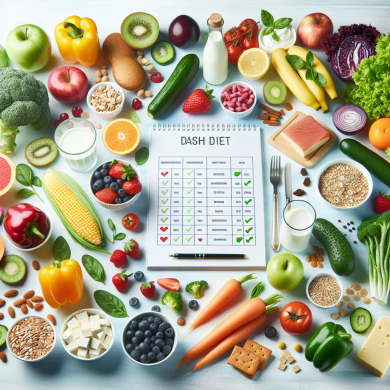Unlock Weight Loss with the DASH Diet
“`html
Introduction to the DASH Diet
The Dietary Approaches to Stop Hypertension (DASH) diet was initially designed to combat high blood pressure, but it has since gained popularity as an effective weight loss strategy. The DASH diet emphasizes the consumption of whole foods such as fruits, vegetables, lean proteins, and whole grains while reducing sodium intake, making it a versatile and balanced approach to nutrition. This article explores how the DASH diet can be a powerful tool for weight loss and overall health improvement.
The Principles of the DASH Diet
Focus on Nutrient-Dense Foods
The DASH diet prioritizes nutrient-dense foods that are rich in essential vitamins and minerals. This includes a variety of fruits and vegetables, which provide fiber, antioxidants, and phytochemicals that are crucial for maintaining good health and supporting weight loss. Whole grains, lean proteins, and healthy fats also play a significant role in this diet, contributing to a balanced intake of macronutrients.
Reducing Sodium Intake
A key component of the DASH diet is its emphasis on reducing sodium intake. High sodium consumption is linked to increased blood pressure and can lead to water retention, which may contribute to weight gain. By focusing on fresh, unprocessed foods and using herbs and spices for flavoring instead of salt, the DASH diet helps individuals lower their sodium intake and promote better heart health.
Portion Control
The DASH diet encourages mindful eating and portion control. By being aware of portion sizes and eating in moderation, individuals can better manage their caloric intake, which is essential for weight loss. The diet provides guidelines on serving sizes for different food groups, helping individuals make informed choices about their meals.
How the DASH Diet Promotes Weight Loss
Caloric Deficit
Weight loss fundamentally requires a caloric deficit, where the number of calories burned exceeds the number of calories consumed. The DASH diet naturally supports this process by focusing on whole foods that are lower in calories and higher in nutrients. By consuming foods that are filling yet low in calories, individuals can reduce their overall caloric intake without feeling deprived.
Increased Satiety
The high fiber content of the DASH diet’s fruit, vegetable, and whole grain components helps increase satiety, reducing the likelihood of overeating. Fiber slows digestion, helping individuals feel fuller for longer periods and reducing the temptation to snack between meals.
Blood Sugar Stabilization
The DASH diet includes complex carbohydrates with a low glycemic index, which helps stabilize blood sugar levels. Stable blood sugar reduces cravings and prevents spikes and crashes that can lead to overeating. By keeping blood sugar levels steady, the DASH diet aids in maintaining energy levels and promoting weight loss.
Implementing the DASH Diet for Weight Loss
Meal Planning and Preparation
To effectively follow the DASH diet, planning and preparing meals ahead of time can be beneficial. This involves creating a weekly meal plan that incorporates a variety of foods from all the recommended categories. Preparing meals at home allows for better control over ingredients and portion sizes, aligning with the diet’s principles.
Incorporating Physical Activity
While the DASH diet focuses on dietary changes, combining these efforts with regular physical activity can enhance weight loss results. Exercise helps increase caloric expenditure and improves cardiovascular health, complementing the benefits of the DASH diet. Individuals should aim for at least 150 minutes of moderate-intensity aerobic activity per week, alongside strength-building exercises.
Monitoring Progress
Tracking progress is vital when following the DASH diet for weight loss. Keeping a food diary or using a mobile app can help individuals stay accountable and identify patterns or areas for improvement. Regular weigh-ins, measuring body composition, and assessing how clothes fit can also provide insights into progress.
Overcoming Challenges with the DASH Diet
Adapting to Lower Sodium Levels
Transitioning to a lower sodium intake can be challenging for those accustomed to high-sodium diets. It may take time to adjust to the flavors of foods without added salt. Experimenting with herbs, spices, vinegar, and citrus can enhance flavors without increasing sodium content.
Maintaining Variety
To prevent boredom and ensure nutritional adequacy, it’s important to maintain variety in the diet. Trying new recipes, incorporating different fruits and vegetables, and exploring various cuisines can keep meals interesting and enjoyable.
Managing Social Situations
Social events and dining out can present challenges for those following the DASH diet. Planning ahead by reviewing menus, suggesting restaurants with healthy options, or offering to bring a DASH-friendly dish to gatherings can help individuals stay on track without feeling left out.
The Broader Health Benefits of the DASH Diet
Beyond weight loss, the DASH diet offers numerous health benefits. By promoting heart health, reducing the risk of type 2 diabetes, and supporting overall well-being, the DASH diet is a sustainable and effective approach to long-term health management.
Improved Heart Health
By lowering sodium intake and emphasizing heart-healthy foods, the DASH diet helps reduce blood pressure, lowering the risk of heart disease and stroke. The inclusion of potassium-rich foods also supports heart health by counteracting the effects of sodium.
Reduced Risk of Diabetes
The focus on whole grains, lean proteins, and healthy fats helps regulate blood sugar levels, reducing the risk of developing type 2 diabetes. Moreover, the DASH diet’s emphasis on fiber-rich foods aids in maintaining healthy insulin sensitivity.
Enhanced Overall Well-being
The nutrient-dense foods recommended by the DASH diet contribute to improved overall health. Increased energy levels, better digestion, and a strengthened immune system are just a few of the positive effects reported by individuals who adopt this eating plan.
Conclusion
The DASH diet offers a comprehensive and sustainable approach to weight loss and health improvement. By focusing on nutrient-dense foods, reducing sodium intake, and encouraging portion control, this diet can help individuals achieve their weight loss goals while enhancing their overall health. With its emphasis on balance and moderation, the DASH diet is a practical and accessible option for those seeking to unlock the benefits of healthy eating and weight management.
“`
This article provides a detailed overview of the DASH diet’s principles, benefits, and strategies for implementation, making it a compelling choice for individuals looking to improve their health and lose weight.















Add comment